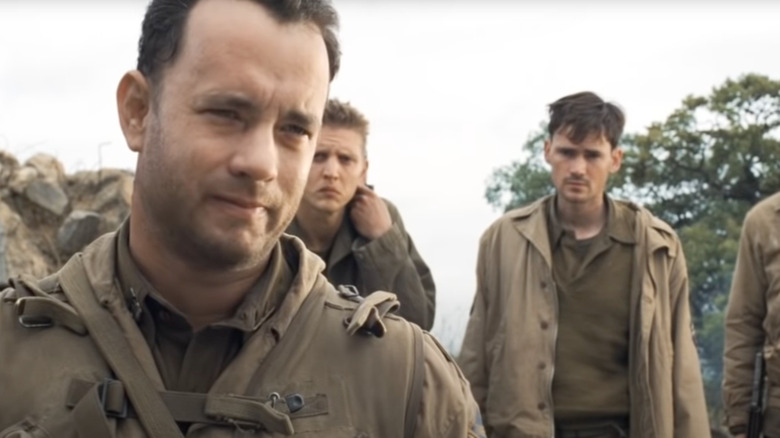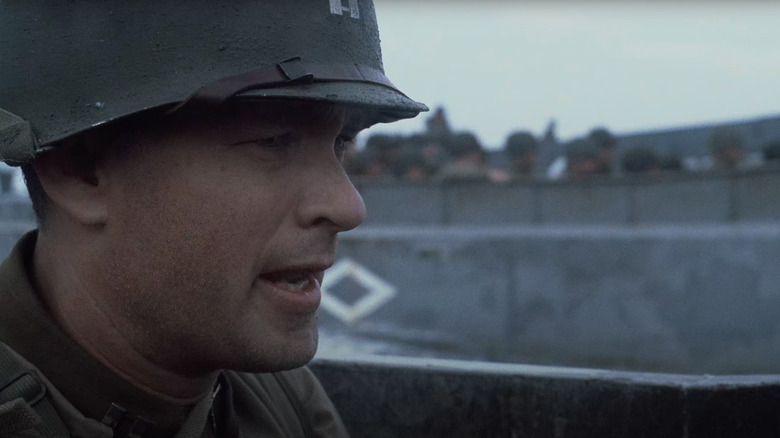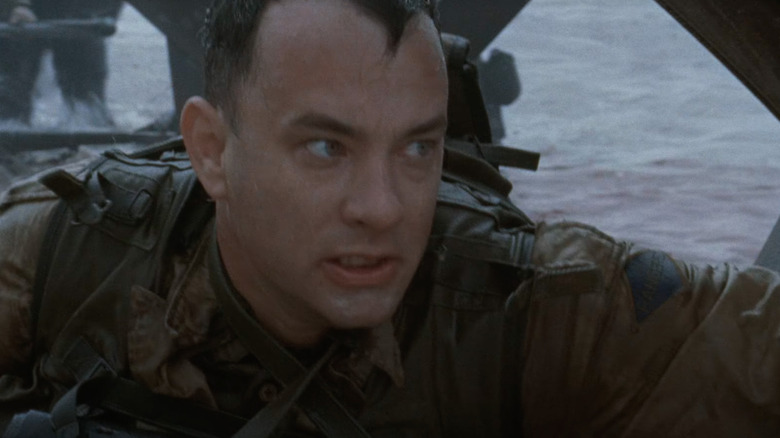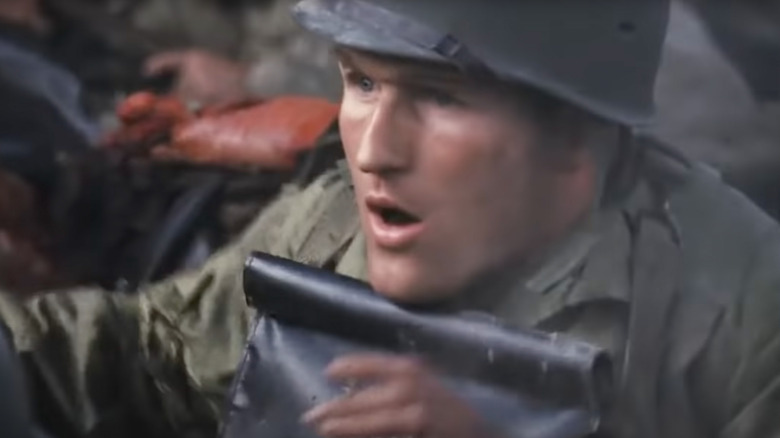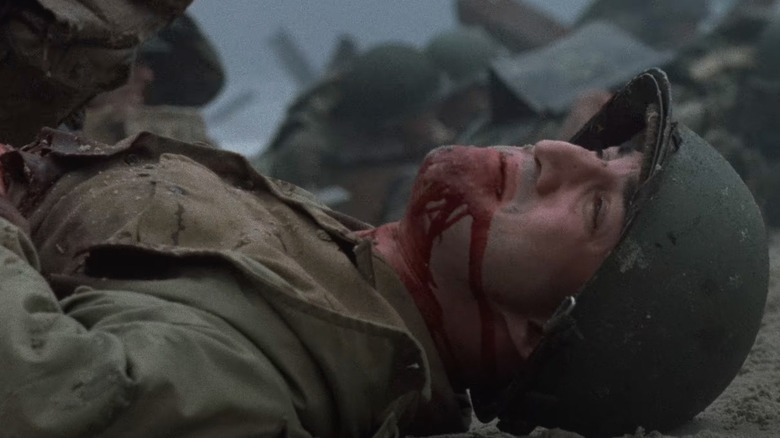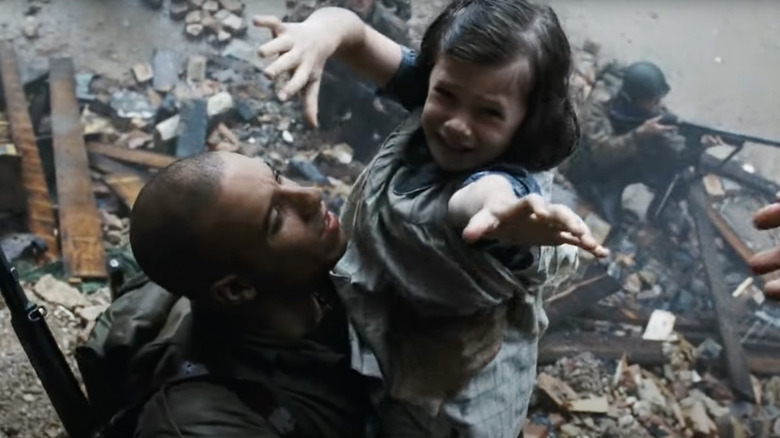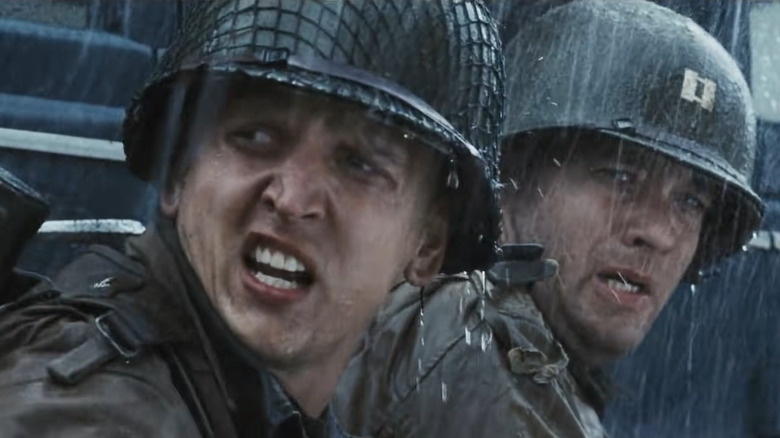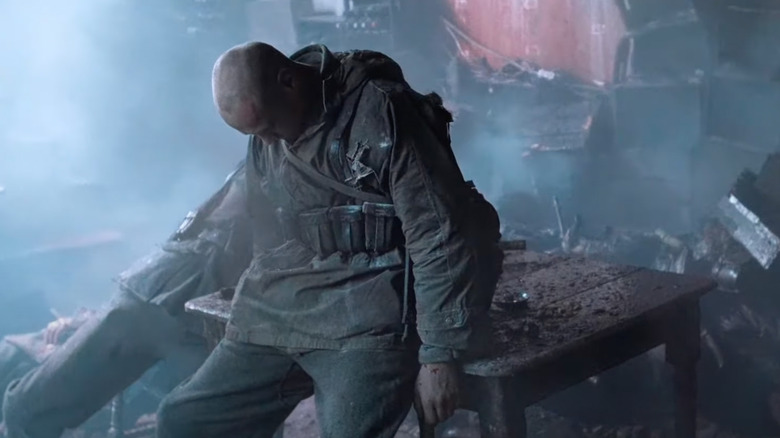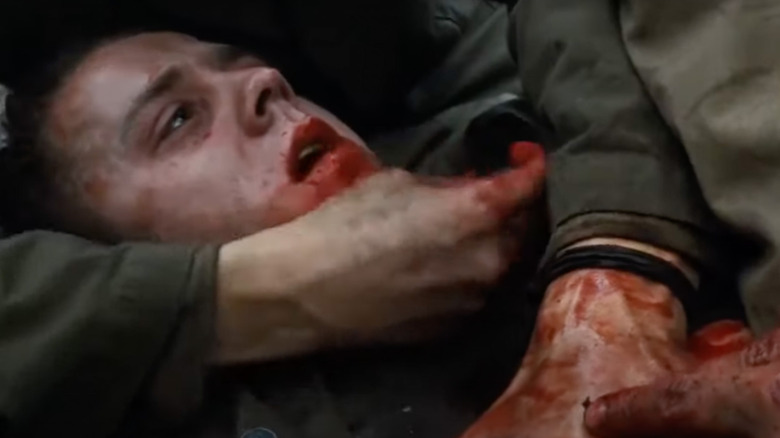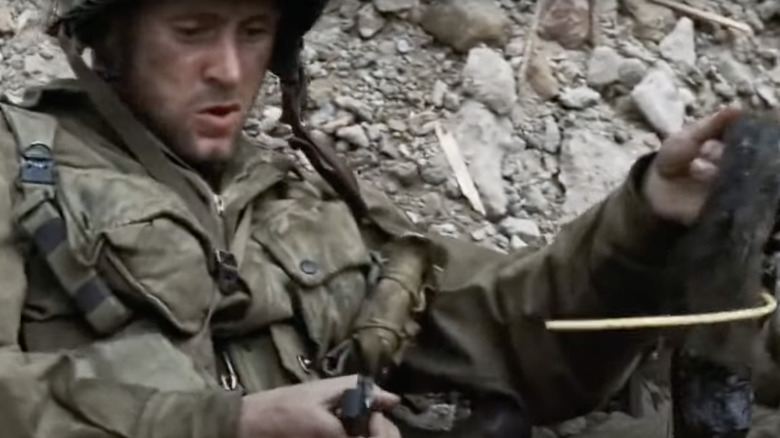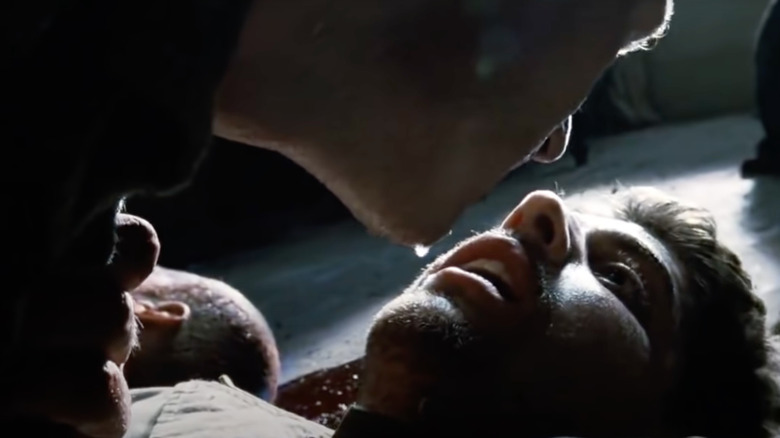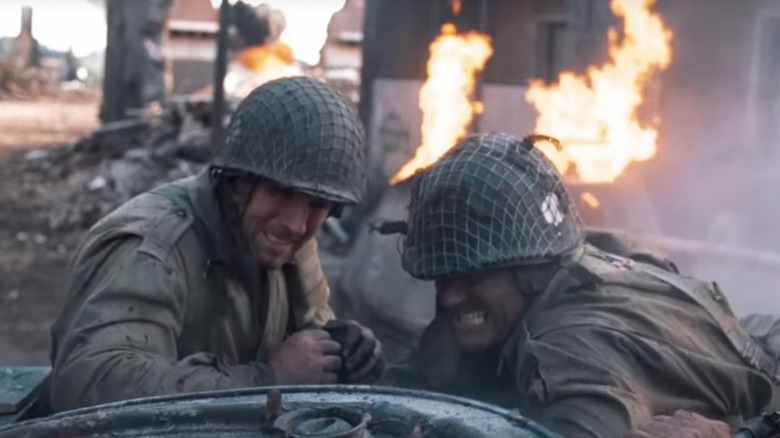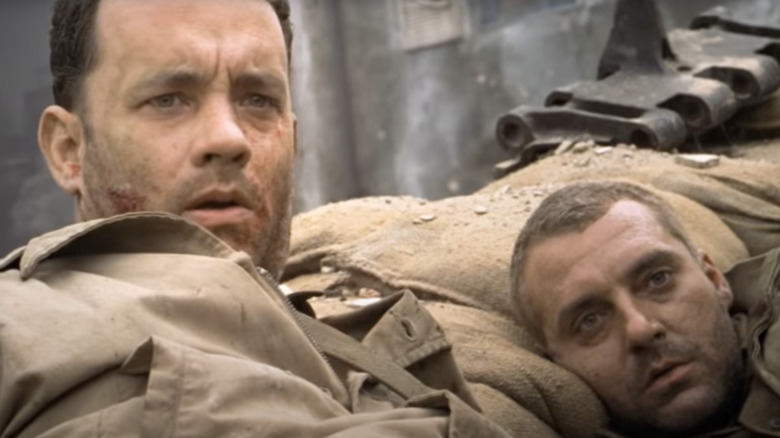The Most Brutal Moments In Saving Private Ryan
As far as war films go, you can't do much better than Steven Spielberg's "Saving Private Ryan." The World War II epic blasted into theaters in July of 1998 and quickly found favor in the eyes of critics and moviegoers, who shelled out over $485 million in ticket sales. Starring Tom Hanks, Edward Burns, Matt Damon, and Tom Sizemore, "Saving Private Ryan" went on to win a handful of Academy Awards, including best director for Spielberg, but ultimately lost best picture to "Shakespeare in Love" — which is just one of the controversies surrounding the film.
While "Saving Private Ryan" is relatively tame compared to modern-day entertainment like "Game of Thrones," at the time of its release, Spielberg's picture was considered one of the most violent films ever made. The MPAA even considered slapping the film with an NC-17 but settled on an R-rating. "Saving Private Ryan" is undoubtedly violent, sometimes to a fault, but the raw carnage highlights the gritty realities of war for better or worse.
Nearly 25 years after its release, we decided to highlight the most brutal moments in the picture, if only to remind our readers that when it comes to realism, no one does it quite like Spielberg.
Higgins boat massacre
Steven Spielberg kicks "Saving Private Ryan" off with one of the most shocking opening sequences in film history: the storied Normandy Invasion on June 6, 1944. Following a prologue in which an older man visits Normandy American Cemetery with his family, we cut to Capt. John H. Miller (Tom Hanks) huddled in a Higgins boat with a squad of soldiers. The camera pans around the various men. Some throw up, and others say prayers or stare blankly at their steel enclosure. Bombs erupt in the distance, followed by gunfire.
"Clear the ramp! Thirty seconds! God be with you," yells the driver.
Capt. Miller barks a few orders and even offers some suggestions — "Move fast and clear those murder holes!" — before shouting, "I'll see you on the beach."
A beat. Then the ramp lowers, and the massacre commences. The first row of men is gunned down before they can step off the boat. Spielberg cuts to Miller's perspective, and we see bodies punctured with holes before keeling over. It's as horrific a scene as any in modern cinema and an absolute tone-setter for the rest of the film. "This isn't your granddaddy's war film," Spielberg seems to say. No kidding.
Carnage on the beach
Capt. Miller manages to leap over the side of the Higgins boat into the ocean. He passes other soldiers whose bullet-riddled bodies stream blood while others are weighed down by their heavy equipment and drown. Miller struggles but manages to make it to shore, where bloody chaos ensues. A bomb goes off nearby and hurls him to the ground. Miller sits up, his ears ringing, and takes note of the violence around him.
Bullets whiz by, and explosions blast the advancing troops to bits. A bullet hits the tank of a flamethrower on the back of a soldier, causing an explosion that kills three men; a soldier stumbles around, searching the ground for something, leans over, and picks up his severed arm. The entire sequence plays like something out of a horror film and is undeniably gut-wrenching.
If that weren't enough, Miller then grabs a man and drags him across the sand. Another bomb goes off, again knocking Miller to the ground. He gets to his feet and resumes his duty, carrying the soldier behind him, but quickly sees that the explosion blew the man in half — Miller is dragging the upper torso!
"Saving Private Ryan" is not the sort of film you watch with popcorn and soda.
D-Day head shots
Later in the violent D-Day sequence, our heroes, led by Captain Miller and Sergeant Mike Horvath (Tom Sizemore), manage to move their men off the beach and dig in directly below the German bunkers. A series of brutal headshots follows: A radioman has his face blown off, and a dying man is hit in the head just as a frustrated medic (Giovanni Ribisi) manages to fix his wounds. Moments later, another bullet grazes an unnamed soldier's helmet. Stunned, the man removes his protective gear and rubs his head.
"Lucky bastard," Adrian Carpazo (Vin Diesel) shouts.
Unfortunately, half a second later, another bullet blows the back of the soldier's exposed head off. He topples over, dead on impact. This moment is about as close to humor as "Saving Private Ryan" gets in its opening scene, and the results are so shocking you can only shake your head in disbelief.
Kid crying on the beach
Finally, to ensure audiences get the message that war is hell, Spielberg cuts to more beach carnage. Men scramble about, pray, search for ammunition, tend to wounds, or duck behind hedgehogs. Worst of all, an unnamed soldier lies on his back, covered in blood, holding his exposed entrails while crying out for his mother.
While a tad gratuitous, particularly for the 1990s, the moment drives home the point that many soldiers who fought in World War II were young boys barely old enough to drive. Spielberg noted as much in an interview with EW.com. In response to hearing the MPAA wanted to give "Saving Private Ryan" an NC-17 due to its violent content, he proclaimed, "Nobody 14 years old or under should see it. But if you can fight in a war — a lot of the kids who died on Omaha Beach were 17 years old — I don't think there's anything wrong with seeing this picture. I'm not sure that any of those 17-year-olds who landed on Omaha Beach in 1944 were prepared for the fusillade of violence that came pouring down on their heads."
Caparzo's death
After the harrowing D-Day sequence, "Saving Private Ryan" leaps into its main plot. Captain Miller cobbles together a small group of soldiers and heads behind enemy lines to find James Ryan (Matt Damon). Their first stop is the town of Neuville, where the 101st Airborne battles a near-invisible German force. Miller's crew joins up with Sergeant William Hill (Paul Giamatti) and slowly makes its way through the treacherous territory.
At one point, they happen upon a French family desperately trying to escape the carnage. The father begs the soldiers to take his children. Caparzo obliges, despite Miller's objections, noting that the young girl reminds him of his niece. "Captain, the decent thing to do is to at least take her over to the next town," Caparzo says.
"We're not here to do the decent thing," Miller snaps, snatching the girl from his arms, "We're here to follow f***ing orders!"
Suddenly, a bullet hits Caparzo and knocks him to the ground. Everyone ducks for cover and must watch their fellow soldier slowly bleed out while sniper Pvt. Jackson (Barry Pepper) seeks out the enemy. Caparzo, covered in blood and mud and gripping a letter to his father, eventually dies in the street, leading Miller to exclaim, "That's why we can't take children." Point taken.
Sniper through the eye
Jackson later avenges Caparzo's death in one of "Saving Private Ryan's" most incredible moments. As Caparzo lies dying, our resident sniper scans the locale for the shooter. He spots a tower at the other end of town and notes, "That's where I'd be." He tells the others to take cover — "This sniper has talent!" — and positions himself behind some rubble.
Spielberg cuts back and forth between the German sniper and Jackson as they hunt each other through their scopes. Incredibly, the German spots Jackson just in time to see the muzzle flash erupt from his rifle. Jackson's bullet bursts through the German's scope, into his eye, and out the back of his skull. Spielberg captures the shocking moment in gruesome detail, bloody brain matter and all.
It's an incredible sequence that produced oohs and ahhs from audiences, but even the crowd-pleasing moments in "Saving Private Ryan" are difficult to watch.
Germans shot by Hamill
Making their way through Neuville, Capt. Miller's crew takes refuge in a small alley and kicks back for a spell while a runner heads off to find Capt. Hamill. Staff Sgt. Hill uses the opportunity to fish a bit of debris from his boot and ends up knocking over a piece of wood that smashes through a brick wall. Behind the structure, a group of startled Germans grab their guns and frantically shout commands. Miller's team does the same, resulting in an intense standoff. Cpl. Upham (Jeremy Davies) does his best to translate for both parties, but the shouting drowns out his voice.
Before either side can make a move, machine gun fire erupts from above, blood splatters across the white walls, and the German troops drop like flies. It's a meat grinder. One of the victims takes a bullet in the chest and slumps on the table, blood pouring from his mouth.
The camera tilts up and reveals Hamill, played by Ted Danson, standing atop a ledge overlooking the alley, a smoking Thompson submachine gun in his hand.
What makes this moment so brutal is the realistic way Spielberg shoots the action. When Hamill unleashes his fury on the German troops, the camera remains fixed on the bodies as bullets blast them to bits. There are no lavish stunts, quick cuts, or wild camera angles. The realism is shocking.
Wade's death
Miller's crew discovers that Ryan is holed up in a town called Ramelle and makes their way across the countryside. En route, they happen upon a German machine gun nest and, following a brief debate, decide to take it down. Upham watches the attack from afar. Miller's crew opens fire on the Germans and tosses grenades at the nest. After the smoke clears, Miller calls for Upham, and the young soldier makes his way up the hill and finds his squad gathered around Wade, who lies on the ground, his body riddled with bullets.
A gruesome scene follows in which our boys try to save Wade's life. Miller rips the medic's shirt, revealing massive bullet wounds hemorrhaging dark streams of blood. Wade, surrounded by flies, trembles uncontrollably. The team dumps sulfanilamide and water on the wounds, but nothing stops the bleeding. Wade screams about his liver and finally asks for morphine to dilute the pain. Miller obliges. As our heroic medic slips away, he calls out for his mother and tearfully utters that he wants to go home before finally expiring.
Wade's death is the most brutal scene in "Saving Private Ryan" because of how the young man goes out — not with a bang, but with a tearful cry to his mother.
Sticky bomb explosion
Upon its release, much of the dialogue surrounding "Saving Private Ryan" focused on the D-Day sequence that kicks off the film. For me, the big draw to Spielberg's epic has always been the final battle that sees Captain Miller and company defend a bridge from advancing German soldiers. The 30-minute-long sequence is a thrilling piece of action filmmaking that succinctly drives home Spielberg's point: war is hell. So for every unbelievable beat, a harrowing moment arrives to remind you this is more than a typical World War II drama.
At the onset of the climactic assault, Capt. Miller's team tucks TNT into socks coated in axle grease to produce "sticky bombs." Miller instructs his men to place the device on the oncoming tanks to knock the vehicles off their tracks. It's a dangerous tactic, as the sticky bombs carry a short fuse.
We see the results of mistiming this venture when an eager young soldier lights his bomb, rushes to a tank, and explodes in a cloud of blood and guts — a dreadful moment enhanced by the incredible sound design. Luckily, the other soldiers give themselves more time to apply their sticky bombs and accomplish their dangerous objective.
Mellish knife fight
The final battle veers back and forth between thrilling spectacle and shocking realism. An example of the latter occurs when Mellish (engages) engages in a brutal fight with a German soldier. Steven Spielberg toys with audience expectations by having Corporal Upham appear on the stairs with a rifle. Having watched any of the director's films, one would expect the young soldier to burst in at the last second and save the day. Alas, the rescue never arrives.
Instead, Mellish and the German soldier engage in fierce hand-to-hand combat. They punch, kick, and bite one another to no end. Mellish produces a knife and seemingly gains the upper hand. However, the German soldier overpowers our boy, takes the blade, and slowly lowers the weapon into his chest. Mellish begs his enemy to stop, but the German is too strong. Mellish's body withers in pain for a spell and finally goes still.
For his part, the German whispers something in his native language that translates to: "Give up, you don't stand a chance! Let's end this here! It will be easier for you, much easier. You'll see it will be over quickly."
After all of the violence rained down in "Saving Private Ryan," the brutal knife fight is the one that sticks with you most.
20 mm blasts a group of soldiers
Capt. Miller's ragtag team of soldiers holds their own against the well-equipped German force for a good portion of the final battle. They expertly ambush the enemy patrol using mines and Molotov cocktails and even blast the tread off a Tiger tank, thus blocking the remaining enemy vehicles from advancing. Inexplicably, five of Miller's men foolishly leap on the tank and are summarily gunned down by a 20-millimeter cannon that blasts them to bits.
Steven Spielberg cuts to a wide shot to show the bodies exploding and tumbling off the vehicle. The survivors scream in agony, and more Germans arrive to shoot them dead. At this point, the final battle turns for the worst, as Miller fails to support Mellish and loses sniper support when a tank destroys Jackson's position.
Luckily, Pfc. Reiben (Edward Burns) manages to flank and wipe out the 20mm crew just before Horvath hits a tank destroyer with a bazooka, providing Miller's squad a brief opportunity to cross the bridge.
Miller's last stand
Unfortunately, Miller's last stand, dubbed "Alamo," comes at a cost. As the surviving members cross the bridge, Horvath is hit several times by enemy fire and killed, Upham finds himself pinned on the wrong side of the river, and a tank blast knocks Miller off his feet.
Dazed, our fearless Captain makes his way to a detonator needed to blow the bridge and keep it out of enemy hands. Before he can reach his destination, a German soldier — the same man Miller spared earlier in the film — shoots him in the chest. Miller again drops but manages to recover. He positions himself against a motorcycle, draws his .45 pistol, and fires several rounds at the massive vehicle, determined to go down fighting. Inexplicably, the tank explodes. Astonished, Miller looks up and sees a P-51 streak across the sky, followed by an American force replete with Sherman tanks that take out the retreating Germans.
Miller dies from his wounds moments later after urging Pvt. Ryan to "Earn this," a brutal end compounded by the fact that he was mere seconds away from salvation.
As such, the final battle is practically meaningless, as the relief would have arrived in time to keep the bridge from falling into the German's hands. But that's the point. "Saving Private Ryan" is ultimately about the futility of war and the enormous price paid to preserve freedom.
